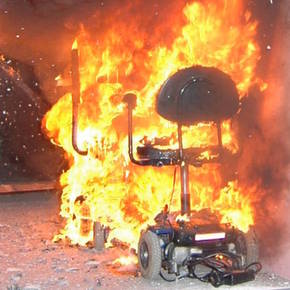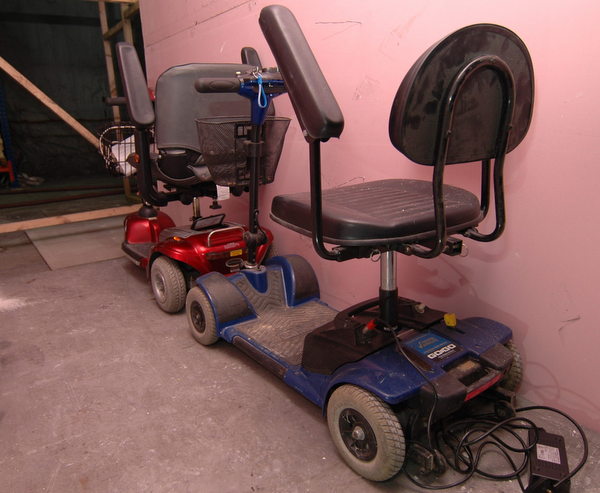
Will the boom in mobility scooters mean more fatal fires in buildings?
 In this special feature article for Buildingtalk, Martin Shipp, Technical Development Director for Fire Safety at BRE Global reviews the fire risks in the UK building and care sector from the rising use of mobility scooters and how we need to act fast to adapt the design and fire safety management of buildings plus urgently update current building and fire regulations.
In this special feature article for Buildingtalk, Martin Shipp, Technical Development Director for Fire Safety at BRE Global reviews the fire risks in the UK building and care sector from the rising use of mobility scooters and how we need to act fast to adapt the design and fire safety management of buildings plus urgently update current building and fire regulations.
Energy efficiency, BIM and ethically sourced construction may be some of the bigger preoccupations of current building design and management.
But with an ageing population and growing problem of obesity, there is another challenge which is rapidly creeping up on us. How do we safely house a booming population of mobility scooters?
The elderly population is the fastest growing in the UK. Data from the Office of National Statistics suggests that people aged 65 or over will account for almost a quarter (24.3%) of the UK population by 2039.
There is also talk of an obesity epidemic. The government predicts that 60% of men, 50% of women and 25% of children in Britain will be obese by 2050 unless the problem is tackled.
These 21st century phenomena are creating the perfect storm for an influx of mobility scooters into the built environment.
It is hardly surprising, then, that the UK is one of the fastest growing markets for mobility scooters in Europe. A government backed study in 2014 put the number of users at between 300,000 and 350,000. And the figures are rising: sales of mobility scooters are increasing at a rate of around 5-10% per annum.
Mobility scooters are to be embraced, of course, helping those that use them to maintain their independence and social contact.
Class 2 ‘boot’ scooters, which are intended for footway use and limited to a maximum speed of 4mph, are the most popular. They do not need registering with the DVLA and, due to their relatively light and compact footprint, are often parked indoors.
Yet much of our housing stock, and especially multi-occupancy dwellings, was never designed to garage these mini-vehicles close at hand to their owners.
Residents in sheltered accommodation, for example, often have no space to keep them in their home – if they can actually get them through the door. So machines are typically left outside within the communal corridor or hallway.
Adding to the challenge, it is not uncommon for users to own more than one mobility scooter, or a wheelchair as well. Machine designs are also becoming more substantial, with some models now catering for weights of typically up to 40st.
Finding space for them, however, is just the tip of the iceberg.
Mobility scooters fire risk research
Headlines in the national press in recent years have implicated mobility scooters in serious fire incidents. One report describes the scooter as having ‘exploded’. And there have been fatal fires; one caused by a mobility scooter left charging overnight, and another resulting from an arson attack on a machine.
The fire and rescue services, and other agencies, have long recognised the fire risks of mobility scooter. Some of them issue advice and guidance on solutions to their storage.
Now, recent research into the characteristics of burning mobility scooters, co-funded by the BRE Trust and Welwyn Garden City Housing Association, has gone a long way to substantiating the risks.
As well as posing a potential obstruction to escape, there is evidence that mobility scooters present a fire risk in themselves, often when charging. A burning scooter also produces quantities of smoke and heat, exacerbating the spread of a fire and further jeopardising safe escape.
BRE Global carried out an experiment to measure the heat release and smoke production rates from two Class 2 rated mobility scooters – the type often brought indoors.
Within five minutes of fire taking hold of the first scooter, it had spread to the second. After seven minutes, gas temperatures at ‘ceiling height’ had reached just over 1000OC. By this time, a substantial quantity of smoke was also being produced. It follows that bigger scooters (or a greater number) are likely to lead to far more severe fires and quantities of smoke.
The findings are not intended to suggest that any particular make or model of mobility scooter performs better or worse in a fire. What they do provide is compelling evidence of the fire risks and pressing need to address them in fire safety management if not building design.
Clearly, a fire involving mobility scooters within the confines of a corridor or stairway will create a substantial risk to occupants. The resulting smoke and heat will make affected routes impassable and put at risk any occupants who open their doors.
It is a modern paradox; while indispensable to quality of life for those that use them, mobility scooters may be putting lives at risk, especially when parked in corridors or communal space within multiple occupancy buildings. These could be council flats, social housing, sheltered accommodation, care homes and retirement complexes, many of which cater for a higher proportion of elderly residents or people with limited mobility.
Objective assessment
For the first time, the data allows an objective assessment to be made of the real fire risks from these machines, providing design parameters to inform the work of designers, fire engineers and fire risk assessors. It is also intended to help housing managers and care service providers to implement an appropriate level of fire safety for residents with minimal impact on normal life. Additionally, the fire behaviour demonstrated will be of interest in the risk management of other public facilities, such as shopping malls, restaurants, theatres, cinemas, and so on.
Certainly, BRE’s findings have been welcomed in many areas, since there is no specific guidance on mobility scooters in current building regulations or fire regulations. The nearest relevant provision is that escape routes and common areas of premises should be kept clear of combustible materials and obstructions.
Of course, new build projects provide a major opportunity to design out the risk. This could be through the incorporation of separate storage and ‘scooter parks’ away from residential blocks.
When it comes to existing properties, the Responsible Person identified under the Regulatory Reform (Fire Safety) Order faces a legal obligation to assess and mitigate the risks.
As a potential obstruction to fire escape, mobility scooters must be included in the landlord or housing provider’s risk assessment of all common areas of properties. This will allow any associated fire risk and those affected to be identified as the basis to taking steps to minimise or remove that risk.
Storage further away from the owner’s dwelling may be acceptable through mutual arrangement between the owner and housing agent. This could be in the form of a specially constructed or proprietary store, either permanent or stand-alone, as long as it is dry, secure and has an electricity supply for charging.
Sprinkler system
Depending on internal design and fire safety management, the installation of a fire suppression or sprinkler system within a room identified for scooter storage may be feasible.
This is the focus of a series of experiments by BRE Global, commissioned by Lewisham Homes, to examine the effectiveness of sprinklers on burning mobility scooters.
Fire tests have been undertaken in the BRE Burn Hall to replicate sprinkler-protected rooms/lounges within the client’s properties which are being evaluated for mobility scooter storage. Experiments so far, involving several scooters, have shown that the sprinkler installation was able to effectively suppress the fire in the experimental compartment before it reached a critical stage.
The findings will eventually provide a data resource for the fire safety engineering of flats, care homes and sheltered accommodation and other types of occupancies where mobility scooters may be found.
The concerns over mobility scooters are well-founded. The UK building and care sector need to act fast to adapt the design and fire safety management of communal buildings to achieve a safer, more convenient fit between these machines and our homes.
Additional links
BRE’s full report “Heat release and smoke production from burning mobility scooters” – downloaded free-of-charge.
Video of the mobility scooter fire experiment.
More details of BRE’s experiments for Lewisham Homes on sprinkler systems and mobility scooters.
Latest news

21st February 2025
ASSA ABLOY EMEIA: Save valuable time and money with a seamless switch to programmable digital keys
In 2025, access management can be a whole lot easier. By making access part of their digital processes, businesses can put time-consuming key management and the cost of changing the locks firmly behind them. Making this switch is a lot easier than many people think, as ASSA ABLOY explains here…
Posted in Access Control & Door Entry Systems, Architectural Ironmongery, Articles, Building Industry News, Building Products & Structures, Building Services, Doors, Facility Management & Building Services, Health & Safety, Information Technology, Innovations & New Products, Retrofit & Renovation, Security and Fire Protection
21st February 2025
Showersave supports industry leaders in addressing Part L and Part G regulations
Showersave has sponsored and participated in a recent Building Insights LIVE roundtable on ‘Water & Energy Saving Innovations in New Build Housing’.
Posted in Articles, Bathrooms & Toilets, Bathrooms, Bedrooms & Washrooms, Building Associations & Institutes, Building Industry Events, Building Industry News, Building Products & Structures, Building Regulations & Accreditations, Building Services, Exhibitions and Conferences, Interiors, Pipes & Fittings, Plumbing, Retrofit & Renovation, Sustainability & Energy Efficiency
21st February 2025
GEZE: The importance of Specifying High Quality Door Closers on Fire Doors
Andy Howland, Sales & Marketing Director at GEZE UK, discusses why specifying high quality door closers on fire doors is important…
Posted in Access Control & Door Entry Systems, Accessibility, Architectural Ironmongery, Articles, Building Industry News, Building Products & Structures, Building Regulations & Accreditations, Building Services, Doors, Facility Management & Building Services, Health & Safety, Posts, Restoration & Refurbishment, Retrofit & Renovation, Security and Fire Protection
21st February 2025
Insight Data achieves ISO9001 recertification with zero non-conformities
Leading industry data specialist, Insight Data, has successfully achieved the prestigious recertification for ISO9001 with zero non-conformities for the fourth consecutive year.
Posted in Articles, Building Industry News, Building Regulations & Accreditations, Building Services, Information Technology, Research & Materials Testing
 Sign up:
Sign up: 